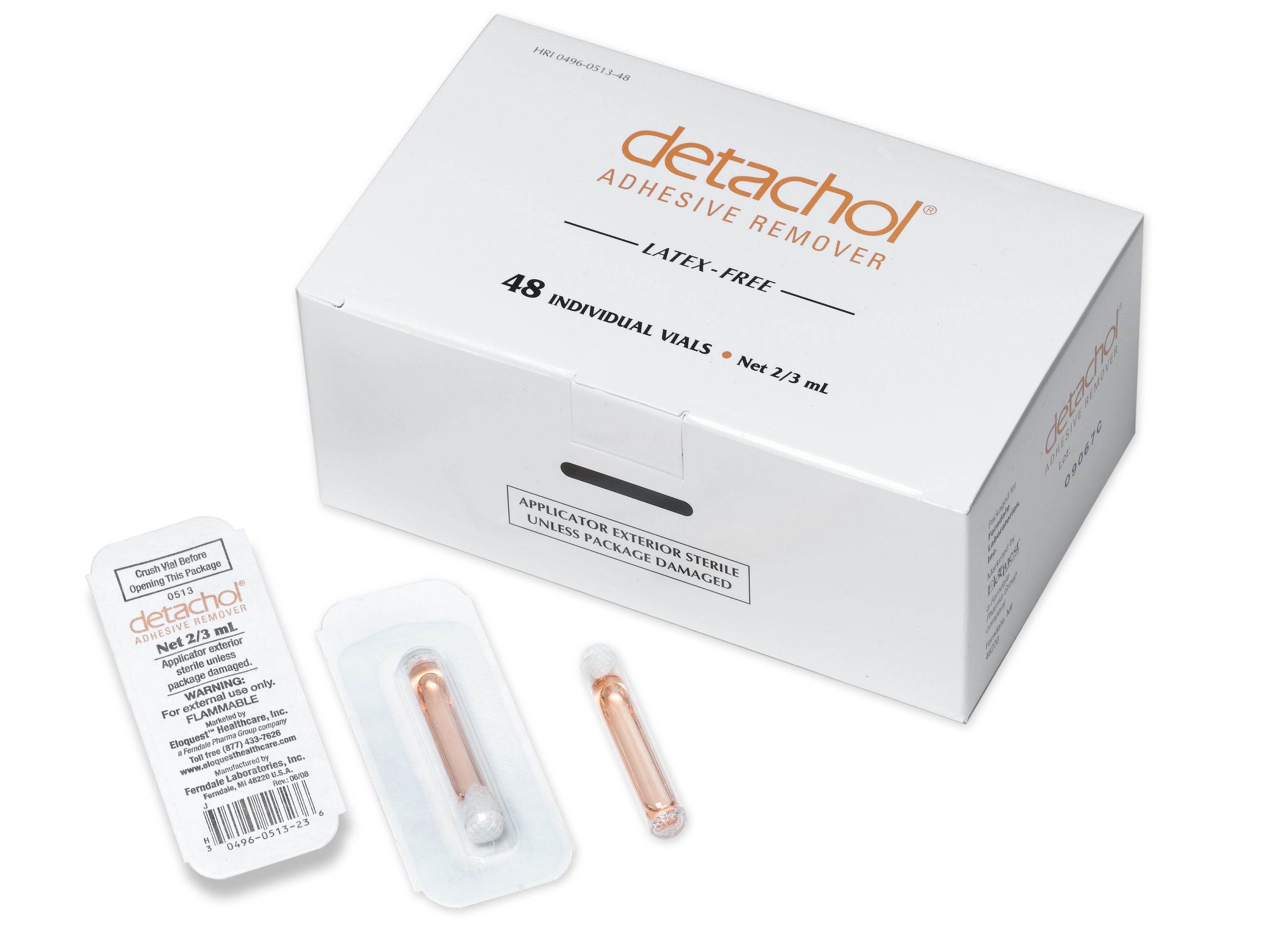Use the table below to browse our clinical evidence or sort by keyword. To access the data click the ‘View’ column.
Detachol Clinical Evidence & Resources
Sales Materials & Resources
Clinical Evidence
| wdt_ID | Category | Author | Key Findings | Purpose | Setting | Device/Dressing being removed in study | View Data |
|---|---|---|---|---|---|---|---|
| 1 | Patient Safety | Fowler¹ | Detachol® Adhesive Remover has been found to be safe and effective in an irritancy study, with patch-and-repeat open application testing revealing no propensity toward allergic or irritant contact dermatitis. | To determine the role Detachol® may play in local skin reactions | Laboratory setting/ volunteers | N/A | View |
| 2 | Patient Safety | Ryder and Duley² | No significant difference in the reduction of normal skin flora was observed on skin prepped with CHG/IPA vs skin prepped with CHG/IPA followed by Mastisol or Detachol. Use of Mastisol or Detachol did not affect the antiseptic effectiveness CHG/IPA. | Evaluated compatibility of 2% clorhexidine gluconate/70% isopropyl alcohol (CHG/IPA) with Mastisol and Detachol to determine whether either product affected the antiseptic effectiveness of CHG/IPA. | Laboratory setting/ volunteers | N/A | View |
| 3 | Patient Safety | Deneau and Craig³ Cookeville Regional Medical Center | Observations of multiple patients who have received application of Detachol® Adhesive Remover before dressing removal have revealed a low incidence of allergic reaction, effective removal of adhesive residue, increased nursing efficiency associated with removal of tape and dressings, and decreased patient pain with adhesive product removal. | Evaluated effectiveness of products for enhancing CVC dressing securement and removal. | ICU | CVC Dressings | View |
| 4 | Patient Safety | DeVries et al.⁴ Methodist Hospitals | Over 30,000 vascular access device sites were assessed with no dressing-related skin injuries reported following the implementation of a care bundle that included Mastisol and Detachol. | Assessed peripheral IV (PIV) dressing adherence following implementation of care bundle including Mastisol and Detachol in a pilot study | Large community hospital | PIV and CVC Dressings | View |
| 5 | Patient Safety | McNichol et al.⁵ | Research reports have demonstrated that the use of solvents to break the adhesive bond between the skin and an adhesive product is an effective method for preventing skin injury associated with adhesive removal. | To define best practices for prevention of medical adhesive-related skin injury (MARSI). A multidisciplinary group of subject matter experts outlined consensus statements on the assessment, prevention, and treatment of medical adhesive-related skin injury. | Consensus Panel | N/A | View |
| 6 | Cost Avoidance | Groom et al.⁶ | Economic studies have reported that the cost to treat a skin tear from incidence to complete resolution (approximately 2 weeks) is $21.96 per week. | Pilot study comparing a regimen using a skin care product line containing active ingredients and nutrients with a commercially available alternative skin care regimen. Incidence of skin tear data was collected. | Elderly convalescent care hospital-based center | N/A | View |
| Category | Author | Key Findings | Purpose | Setting | Device/Dressing being removed in study | View Data |
Need more assistance? We’re happy to connect you with your local representative, give us an email at information@eloquesthealthcare.com!
Detachol Video Library


References
References
- Data on file: Irritancy testing results.
- Ryder M, Duley C. Evaluation of compatibility of gum mastic liquid adhesive and liquid adhesive remover with an alcoholic chlorhexadine skin preparation. J Infus Nurs. 2016;40(4):245-252.
- Deneau J, Craig A. Nursing Survey Reveals Novel Strategy in Assisting Adherence to Best Practices of CVC Dressing Management. Poster presented at: Institute for Healthcare Improvement National Forum, December 8-11, 2013.
- DeVries M, Sabenoff J, Wickert M. Addressing the Dressing Improving Dressing Disruption in Vascular Access. Poster presented at: 43rd Annual Canadian Vascular Access Conference, April 25-27, 2018.
- McNichol L, Lund C, Rosen T, Gray M. Medical adhesives and patient safety: state of the science: consensus statements for the assessment, prevention, and treatment of adhesive-related skin injuries. J Wound Ostomy Continence Nurs. 2013 Jul-Aug; 40(4): 365-80; quiz E1-2. doi: 10.1097/WON.0b013e3182995516.
- Groom M, Shannon RJ, Chakravarthy D, Fleck CA. An evaluation of costs and effects of a nutrient-based skin care program as a component of prevention of skin tears in an extended convalescent center. J Wound Ostomy Continence Nurs. 2010 Jan-Feb; 37(1): 46-51. doi: 10.1097/WON.0b013e3181c68c89. Erratum in: J Wound Ostomy Continence Nurs. 2010 Mar-Apr; 37(2): 128.

